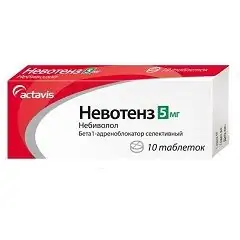Nevotenz
Nevotenz: instructions for use and reviews
- 1. Release form and composition
- 2. Pharmacological properties
- 3. Indications for use
- 4. Contraindications
- 5. Method of application and dosage
- 6. Side effects
- 7. Overdose
- 8. Special instructions
- 9. Application during pregnancy and lactation
- 10. Use in childhood
- 11. In case of impaired renal function
- 12. For violations of liver function
- 13. Use in the elderly
- 14. Drug interactions
- 15. Analogs
- 16. Terms and conditions of storage
- 17. Terms of dispensing from pharmacies
- 18. Reviews
- 19. Price in pharmacies
Latin name: Nevotens
ATX code: C07AB12
Active ingredient: Nebivolol (Nebivolol)
Manufacturer: ACTAVIS, Ltd. (Iceland)
Description and photo update: 2018-25-10

Nevotenz is a selective beta 1- blocker.
Release form and composition
Dosage form Nevotenza - tablets: round, convex on one side, white, on the convex side there is a marking "N 5", on the reverse side there is a cruciform risk with a rising edge on each of the divided sectors (7 and 10 pcs. In blisters, in a cardboard box 1, 2, 4 or 8 blisters of 7 tablets, or 1, 3, 5 or 10 blisters of 10 tablets).
Composition of 1 tablet:
- active substance: nebivolol (in the form of hydrochloride) - 5 mg;
- auxiliary components: macrogol 6000, magnesium stearate, colloidal silicon dioxide, croscarmellose sodium, lactose monohydrate.
Pharmacological properties
Pharmacodynamics
Nebivolol - the active component of Nevotenza - is a lipophilic, cardioselective beta 1 -adrenergic blocker of the third generation with vasodilating properties. It has antiarrhythmic, hypotensive and antianginal effects. High blood pressure (BP) decreases at rest, during stress and physical exertion. Modulates the release of endothelial vasodilating factor nitric oxide (NO). Selectively and competitively blocks synaptic and postsynaptic beta 1 -adrenergic receptors and makes them inaccessible to catecholamines.
Nebivolol is a racemate composed of two enantiomers: RSSS-nebivolol (L-nebivolol) and SRRR-nebivolol (D-nebivolol). L-nebivolol, by modulating the release of a relaxing factor from the vascular endothelium, has a mild vasodilator effect. D-nebivolol is a highly selective and competitive beta 1 -adrenoceptor blocker (the affinity for beta 1 -adrenergic receptors is 293 times higher than for beta 2 -adrenoceptors).
The hypotensive effect is observed after 2–5 days of regular administration of Nevotenza, a stable effect develops after 1 month and persists with prolonged treatment. The antihypertensive property of the drug is also associated with its ability to reduce the activity of the renin-angiotensin-aldosterone system.
Nebivolol improves the indices of intracardiac and systemic dynamics, slows down the heart rate (HR), improves the diastolic function of the heart (decreases filling pressure), decreases the end-diastolic pressure of the left ventricle, decreases the total peripheral vascular resistance, and increases the ejection fraction.
Reduces myocardial oxygen demand (due to a decrease in heart rate, a decrease in pre- and afterload), thereby improving exercise tolerance, reducing the number and severity of angina attacks.
The antiarrhythmic effect of nebivolol is associated with its ability to suppress cardiac automatism (including in a pathological focus) and slow down AV (atrioventricular) conduction.
Pharmacokinetics
Nebivolol is rapidly absorbed from the gastrointestinal tract after oral administration. Food does not affect its absorption and effectiveness.
The bioavailability of the drug in patients with a slow metabolism is almost complete, in patients with a fast metabolism it is approximately 12%. The metabolic rate does not affect the effectiveness of nebivolol.
Nebivolol is extensively metabolized, in part to form active hydroxy metabolites. The metabolic rate by aromatic hydroxylation is dependent on the CYP2D6 isoenzyme and is genetically determined by oxidative polymorphism.
Plasma clearance in most cases (in patients with a rapid metabolism) is achieved within 24 hours for nebivolol, after a few days - for hydroxy metabolites. Plasma concentrations of 1–30 μg / L are proportional to the dose received.
The drug is characterized by a high binding to plasma proteins (mainly albumin): 98.1% for D-nebivolol, 97.9% for L-nebivolol.
Approximately 48% of the dose is excreted through the intestines, 38% of the dose by the kidneys.
The half-life (T ½) of nebivolol enantiomers in patients with a fast metabolism averages 10 hours, in patients with a slow metabolism the value is 3-5 times higher. T ½ of the hydroxymetabolites of both enantiomers in patients with a fast metabolism averages 24 hours, in patients with a slow metabolism - approximately 48 hours.
The patient's age and gender do not affect the pharmacokinetics of nebivolol.
Indications for use
- arterial hypertension;
- prevention of attacks of stable angina pectoris in patients with ischemic heart disease (IHD);
- chronic heart failure (CHF) - as part of complex therapy.
Contraindications
Absolute:
- cardiogenic shock;
- sick sinus syndrome, including sinoatrial block;
- chronic heart failure in the stage of decompensation (requiring inotropic therapy);
- acute heart failure;
- severe arterial hypotension;
- AV block II and III degree (without an artificial pacemaker);
- severe bradycardia (heart rate less than 50 beats / minute);
- metabolic acidosis;
- severe liver dysfunction;
- pheochromocytoma (without concomitant administration of alpha-blockers);
- severe severe peripheral circulatory disorders (such as intermittent claudication and Raynaud's syndrome);
- depression;
- bronchospasm and bronchial asthma;
- lactose intolerance, lactase deficiency or glucose-galactose malabsorption;
- concomitant use of floktafenin or sultopride;
- age up to 18 years;
- hypersensitivity to one of the components of the drug.
Relative (Nevotens should be used with caution due to the potential risk of complications):
- Prinzmetal's angina;
- AV block I degree;
- liver dysfunction;
- severe renal failure (creatinine clearance less than 20 ml / min);
- hyperthyroidism;
- diabetes;
- chronic obstructive pulmonary disease;
- psoriasis;
- desensitizing therapy;
- advanced age (over 65).
Instructions for use of Nevotenza: method and dosage
Nevotenz is taken orally once a day, at about the same time of day. The tablets should be swallowed whole and washed down with a sufficient amount of liquid. Meal time does not matter.
Ischemic heart disease and arterial hypertension
Nevotenz can be used as a monopreparation or as part of a combination therapy.
The average daily dose is 5 mg. It is increased to a maximum of 10 mg, if the drug did not provide the required action in the previous dose.
The optimal effect appears within 1–2 weeks, sometimes after 4 weeks.
The initial daily dose of Nevotenza for patients with renal insufficiency and the elderly is 2.5 mg (½ tablet). It is increased to a maximum of 5 mg if the effect is insufficient. In severe renal impairment and in the presence of concomitant liver diseases, the maximum daily dose is 10 mg. Increasing the dose in such patients should be carried out with caution, under strict medical supervision.
Chronic heart failure
The dose for CHF is selected by titration at 2-week intervals until the optimal maintenance dosage is achieved. The initial daily dose is 1.25 mg (¼ tablets), then, if necessary, it is increased first to 2.5–5 mg, then to 10 mg.
The maximum daily dose of Nevotenza is 10 mg.
Within two hours after taking the first dose and after each increase, the patient should be under medical supervision.
During the selection of the dose, it is recommended to control the heart rate, blood pressure, the severity of the symptoms of the disease.
In case of drug intolerance or worsening of CHF during the titration phase, the dose of Nevotenza should be reduced. If there is a pronounced arterial hypotension, symptoms of bradycardia or AV blockade, pulmonary edema or cardiogenic shock develops, the drug should be discontinued immediately.
Side effects
- from the cardiovascular system: a pronounced decrease in blood pressure, heart rhythm disturbances, peripheral circulation disorders (cyanosis, feeling of coldness in the extremities), orthostatic hypotension, bradycardia, AV blockade, peripheral edema, cardialgia, Raynaud's syndrome, shortness of breath, heart failure, and also aggravation of the course of CHF (mainly during titration of the dose of the drug);
- from the central nervous system: nightmares, drowsiness / insomnia, decreased ability to concentrate, increased fatigue, headache, depression, dizziness, hallucinations, paresthesia, loss of consciousness;
- from the respiratory system: rhinitis, bronchospasm (including in patients without a history of obstructive pulmonary disease);
- from the digestive system: dryness of the oral mucosa, constipation / diarrhea, flatulence, nausea;
- allergic reactions: alopecia, hyperemia of the skin, erythematous rash, pruritus, angioedema;
- others: exacerbation of psoriasis, hyperhidrosis, visual impairment (dry eyes), photodermatosis, impaired potency.
Overdose
Symptoms: cyanosis, nausea, vomiting, bronchospasm, loss of consciousness, marked decrease in blood pressure, AV blockade, severe bradycardia, acute heart failure, cardiogenic shock, coma, cardiac arrest.
First aid measures in case of overdose - gastric lavage and intake of activated charcoal.
With a pronounced decrease in blood pressure, the patient should be given a horizontal position with raised legs. Intravenous fluids, vasopressors, glucagon may be required.
With severe bradycardia, intravenous administration of atropine (0.5–2 mg) is indicated. If there is no improvement, a transvenous artificial pacemaker is placed.
In case of development of atrioventricular blockade (II – III grade), beta-adrenomimetics are administered intravenously. If they prove ineffective, consider setting up an artificial pacemaker.
With ventricular premature beats, lidocaine is prescribed. Class IA antiarrhythmics are contraindicated.
To eliminate the seizures that have arisen, diazepam is administered intravenously.
Treatment for heart failure begins with diuretics and cardiac glycosides. If there is no effect, it is advisable to administer vasodilators, dobutamine or dopamine.
It is possible to arrest bronchospasm by intravenous administration of beta 2 -adrenomimetics.
special instructions
At the beginning of therapy, daily monitoring of blood pressure and heart rate is required. In elderly patients, renal function should be monitored every 4–5 months.
Nevotens does not affect glucose concentration. However, care should be taken when treating diabetic patients because nebivolol may mask some of the symptoms of hypoglycemia (eg, tachycardia). Control of glucose levels should be carried out at least once every 4–5 months.
Smoking decreases the effectiveness of the drug.
Like other beta-blockers, nebivolol can cause bradycardia. If the heart rate is less than 50–55 beats per minute, the dose of Nevotenz should be reduced.
The drug can cause bronchospasm in patients with chronic obstructive pulmonary disease, as well as exacerbation of psoriasis. For patients with these diseases, Nevotenz is prescribed after a careful assessment of the benefit-risk ratio.
With hyperthyroidism, nebivolol levels tachycardia.
With angina pectoris, the dose of Nevotenza should be selected in such a way as to provide a resting heart rate of 55-60 beats per minute, with a load - no more than 110 beats per minute.
Beta-blockers can reduce the production of tear fluid, which should be considered in patients who use contact lenses.
During therapy, an increase in sensitivity to allergens and an increase in the severity of anaphylactic reactions are possible.
Patients who are to undergo surgery need to warn the anesthesiologist about taking Nevotenz.
Cancellation of treatment should be carried out gradually, reducing the dose of the drug for 10-14 days.
Influence on the ability to drive vehicles and complex mechanisms
According to research studies, nebivolol does not adversely affect the rate of psychophysical reactions. For pilots with grade I arterial hypertension, admitted to flight operations, Nevotens is prescribed in an initial dose of 2.5 mg. With good tolerability of the drug, but insufficient control of blood pressure, no earlier than 2 weeks later, the dose is increased to 5 mg.
Some patients may develop side effects from the central nervous system (dizziness most often occurs due to low blood pressure). In such cases, you should refrain from driving vehicles and complex mechanisms. These effects usually occur at the beginning of therapy and after increasing the dose.
Application during pregnancy and lactation
Pregnant women can be prescribed Nevotens only in exceptional cases, when the benefits to the woman are higher than the potential risks to the fetus. When used in late pregnancy, the drug should be discontinued 48–72 hours before the expected date of delivery, since the newborn may develop arterial hypotension, bradycardia, hypoglycemia, and respiratory paralysis. If withdrawal of nebivolol is not possible, the newborn should be closely monitored for the first 2–3 days.
In animal studies, it was found that nebivolol passes into breast milk. In this regard, women are advised to stop breastfeeding if drug therapy is required during lactation.
Pediatric use
For patients under the age of 18, Nevotens is not prescribed due to the lack of clinical data on the safety of its use in this age group.
With impaired renal function
In case of impaired renal function, dose adjustment of Nevotenza is not required.
Caution should be observed when treating patients with severe renal failure (creatinine clearance less than 20 ml / min). The recommended starting dose is 2.5 mg, the maximum daily dose is 5 mg.
For violations of liver function
With moderate impairment of liver function, caution is required during therapy. No dose adjustment is required.
In case of severe violations of liver function, the use of Nevotenz is contraindicated.
Use in the elderly
According to the instructions, Nevotenz can be prescribed to treat elderly patients (over the age of 65), but therapy should be carried out with caution.
Drug interactions
There were no clinically significant changes in pharmacokinetic parameters with the simultaneous use of the following drugs: ranitidine, cardiac glycosides, digoxin, warfarin, furosemide, hydrochlorothiazide, ethanol, nonsteroidal anti-inflammatory drugs, acetylsalicylic acid as an antiplatelet agent.
With the simultaneous use of nicardipine with nebivolol, the plasma concentrations of both substances increase slightly, but this phenomenon has no clinical significance.
Like other beta-blockers, nebivolol weakens the compensatory mechanisms of the cardiovascular system in shock or arterial hypotension caused by taking floktaphenin.
Sultopride increases the risk of ventricular arrhythmias, especially of the "pirouette" type.
Class I antiarrhythmics and amiodarone can enhance the negative inotropic effect and lengthen the time of excitation through the atria.
Phenothiazine derivatives, barbiturates, tricyclic antidepressants enhance the hypotensive effect of nebivolol.
Drugs that inhibit serotonin reuptake and other drugs that are biotransformed with the participation of the isoenzyme CYP2D6 slow down the metabolism of nebivolol.
Sympathomimetic drugs, when used simultaneously, inhibit the activity of nebivolol.
The use of drugs for general anesthesia during therapy with nebivolol can suppress reflex tachycardia and increase the risk of arterial hypotension.
Cimetidine increases the plasma concentration of nebivolol. There is no information about its effect on the pharmacological effects of the drug.
Antihypertensive drugs, slow calcium channel blockers, nitroglycerin can cause severe arterial hypotension. Particular care should be taken with the simultaneous use of prazosin.
Slow calcium channel blockers (diltiazem, verapamil) increase the negative effect on AV conduction and myocardial contractility. Intravenous verapamil is contraindicated during treatment with nebivolol.
Analogs
Analogues of Nevotenz are: Bivotenz, Nebivator, Binelol, Nebivolol, Nebivolol Stada, Nebivolol Sandoz, Nebivolol Canon, Nebivolol-SZ, Nebivolol-Nanolek, Nebikor Adipharm, Nebivolol-Chaykapharma, Nebileva, Nebivolol-Taykapharma, Nebileva, Nebivolol-Tanez -No.
Terms and conditions of storage
The shelf life is 3 years.
Storage conditions: temperature up to 25 ° С, dry place out of reach of children.
Terms of dispensing from pharmacies
Dispensed by prescription.
Reviews about Nevotense
Reviews about Nevotense are mostly positive. Patients note its high efficiency when used according to indications.
As the disadvantages of the drug, side effects, a large list of contraindications, and a relatively high cost are described.
Price for Nevotens in pharmacies
Approximate prices for Nevotens: for 10 tablets - 180-190 rubles, for 30 tablets - 430-455 rubles.

Anna Kozlova Medical journalist About the author
Education: Rostov State Medical University, specialty "General Medicine".
Information about the drug is generalized, provided for informational purposes only and does not replace the official instructions. Self-medication is hazardous to health!







